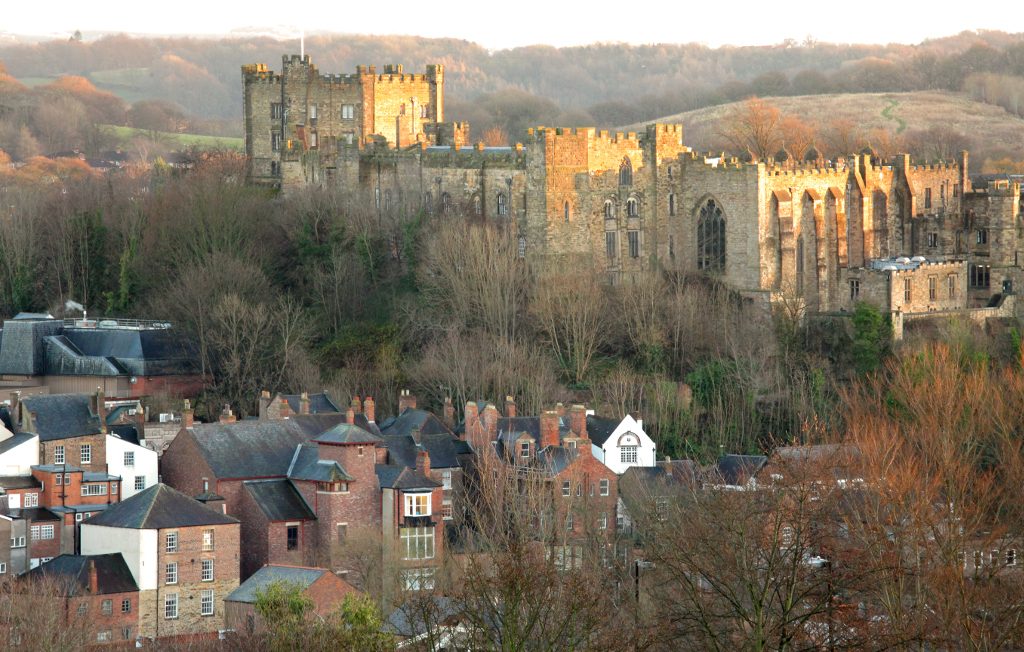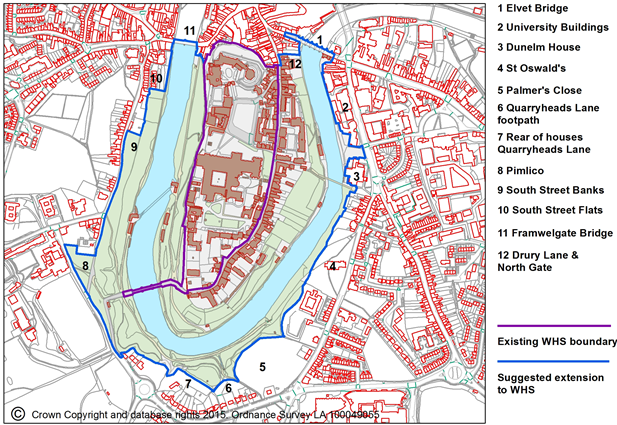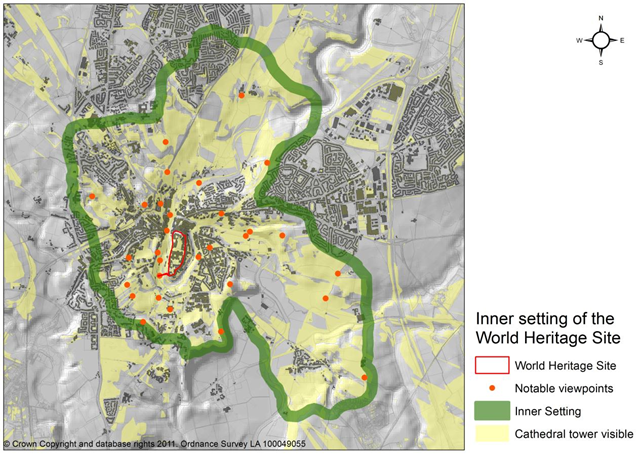Policy H1: Protection of the World Heritage Site
H1.1: Durham Cathedral and Castle World Heritage Site and its setting will be protected by:
- supporting the World Heritage Site Management Plan; and
- supporting the proposed expansion of the World Heritage Site boundary to include all defences, the loop of the river gorge of the Peninsula and inner and outer banks of the River Wear gorge; and
- supporting the proposed boundaries of the inner setting and outer setting within Our Neighbourhood.
H1.2: Development proposals must protect, and preferably enhance, the Outstanding Universal Value of the World Heritage Site.
H1.3: Development proposals must safeguard views in Our Neighbourhood from and to the World Heritage Site, in that they:
- include an assessment of how the finished development will be viewed from and towards the World Heritage Site; and
- are in harmony with the World Heritage Site in terms of scale, massing and choice of materials; and
- provide, wherever possible, an opportunity to open up new views both from and to the World Heritage Site.
4.37 The Durham World Heritage Site has published its first review of its management plan which will run from 2017 to 2023 (Durham World Heritage Site, 2017). Its aims (p.4) are to:
- Protect the Site’s Outstanding Universal Value and setting;
- Conserve and enhance the Site and its setting;
- Support understanding and awareness of the Site and its Outstanding Universal Value and of World Heritage;
- Support communities in realising the economic, social and cultural opportunities and benefits World Heritage status can bring;
- Support visitor and communities’ access, their enjoyment of the Site and its benefits;
- Provide WHS management to deliver all aims.
4.38 The designation of an inner and outer setting of the World Heritage Site is to protect the site and sustain the Outstanding Universal Value. Outstanding Universal Value is “cultural and/or natural significance which is so exceptional as to transcend national boundaries and to be of common importance for present and future generations of all humanity” (UNESCO, 2008, para.49). Durham’s World Heritage Site’s Outstanding Universal Value includes the Cathedral and Castle and associated historic buildings, their landscape setting (comprising the historic City, its buildings and streets, the river and the riverbank, the green assets, and local and long distance views to and from the site), its cultural and religious traditions (historically and currently) and its meaning for people.
4.39 The management plan (Durham World Heritage Site, 2017) has a number of issues in its Action Plan (p.36-45) that are relevant to our Neighbourhood Plan, as listed below:
- Objective 1.1 Ensure the protection of the OUV through planning policy and processes (Action 1.1.1 Liaise with County Durham/ Neighbourhood Plan teams to ensure they accurately reflect the SOUV and attributes of the Site in Local Plans)
- Objective 2.2 Conserve the setting of the WHS and encourage appropriate and sensitive development and support the ongoing regeneration of Durham and its environs. (Action 2.2.1 Build and confirm support for an inner setting area around an expanded WHS core area in lieu of a Buffer Zone; Action 2.2.2 Increase understanding of the inner setting through views and general analysis; Action 2.2.3 Promote the use of ICOMOS Heritage Impact Assessments for new developments in and around the WHS; Action 2.2.4 Make available to prospective developers, descriptions of significance and key factors forming the character of the townscape that support the OUV of the Site; Action 2.2.6 Develop and deliver a programme of more proactive tree management along the riverbanks and upon the Peninsula and continue the conservation of the WHS riverbanks, woodlands and associated structures; Action 2.2.7 Ensure that all maintenance and development plans on the WHS pay due attention to the preservation and support of fauna and flora)
- Objective 2.3 Pursue expansion of the WHS boundary (Action 2.3.1 Review inner and outer riverbanks for potential to become new boundary of the WHS2; Action 2.3.2 Build documentary evidence in support of the conservation and restoration of these historic Green Landscapes)
- Objective 4.1 Maximise the benefits brought to the region by sustainable and appropriate use of the WHS as a visitor attraction and maximise the benefit to the WHS of the local and regional development of Durham’s tourist offer (Action 4.1.2 Integrate the WHS within local and regional tourism strategies)
- Objective 5.3 Increase visitor/user engagement with the WHS (Action 5.3.4 Develop guided walks, controlled public access and new signage and interpretation boards along the riverbanks
- Objective 5.4 Improve physical access to and across the WHS (Action 5.4.1 Improve physical access to and around the WHS for users with disabilities and their carers. Ensure all development projects include consideration of improvements to access; Action 5.4.2 Work in partnership to support the continuation/expansion of the Cathedral Bus service; Action 5.4.3 Work in partnership to address traffic congestion on the peninsula
4.40 The implementation plan will be undertaken by the World Heritage Site Coordinating Committee whose local representatives include Durham Cathedral, Durham University, St John’s College and University College (as landowners, Durham County Council (as a statutory consultee) and the City of Durham Trust.
Map 2: Map of World Heritage Site Boundaries
Map 3: Map of World Heritage Site Inner Setting
Justification
4.41 The Forum’s priority survey (Durham City Neighbourhood Planning Forum, 2015) identified that local people valued highly the World Heritage Site, the Cathedral, the Castle and Palace Green. For them a high priority is to preserve and protect the City’s heritage. In the Forum’s survey of the views of young people (Durham City Neighbourhood Planning Forum, 2016a), their priorities included heritage. The young people all had a strong appreciation of the heritage and architecture of the city and a discernible pride in the historic centre, particularly the Cathedral and Castle.
4.42 Durham Cathedral and Castle were inscribed by UNESCO as a World Heritage Site in 1986 in recognition of its outstanding universal values. The Government is a signatory to the UNESCO (1972) World Heritage Convention and has a statutory duty to preserve World Heritage Sites so that they can be enjoyed by present and future generations (NPPF PPG para 18a-028 to 18a-038). Durham County Council is a member of the World Heritage Site Coordinating Committee which manages the site. Saved policies of the City of Durham Local Plan (City of Durham Council, 2004; Durham County Council, 2015a) cover protection of the World Heritage Site (E3) and extension of its area (E4).
4.43 The exceptional significance of the Norman Cathedral and Castle is manifested by the dramatic group of buildings, situated on the rocky outcrop above the loop in the River Wear. The Cathedral, the largest and most perfect monument of Norman architecture in England, lies within the precincts of Durham Castle, which was first built under the orders of William the Conqueror. The innovative vaulting of the Cathedral constitutes an experiment ahead of its time. The relics of St. Cuthbert (634-687 AD) and the Venerable Bede (672-735 AD) in Durham Cathedral, the Lindisfarne Gospels and Bede’s ‘History of the English Church and People’ crystallise the memory of the evangelisation of Northumbria. The buildings physically express the spiritual and secular powers of the medieval Bishops Palatinate and they remain a political statement of Norman power. Further significance is drawn from the importance of the archaeological remains directly related to the site’s continuity of use and ownership over the past 1000 years as a place of religious worship, learning and residence. These remarkable buildings meet UNESCO’s criteria of Outstanding Universal Value (Outstanding Universal Value) which were updated and ratified by UNESCO in June 2013. The aim of the new management plan’s proposal to extend the coverage of the World Heritage Site is to include all of the Peninsula and its defensive structures and functions. (See Map 2).
4.44 The Site is set in an intimate landscape bowl forming the inner setting with the higher land forming the backdrop to the World Heritage Site (see Map 3). The surrounding green wooded hills, ridgelines and green fingers of land which penetrate into the City, create a magnificent setting for the Cathedral and Castle and include Flass Vale, Whinney Hill, Observatory Hill, Maiden Castle and Mountjoy, together with the River Wear that meanders through the City. Most of Our Neighbourhood is contained within the inner setting of the World Heritage Site. The role of the inner setting is “to protect distinctive views and the distant skyline in key sectors” (Durham World Heritage Site, 2016, p.129). These important viewpoints contributing to the setting, are identified within the County Council’s Conservation Area Character Appraisal (Durham County Council, 2016e), and must therefore be protected from inappropriate development.
4.45 The outer setting comprises the surrounding hills and ridges and wider visual context of the City. To the south the outer bowl is essentially rural with the City confined to the foreground and distant settlements situated below the horizon. To the north the character is more developed but with larger areas of open countryside. There are many vantage points from which the World Heritage Site (and its associated urban and green setting) can be viewed with varying degrees of visibility. The outer edges of Our Neighbourhood lie in the outer setting of the World Heritage Site.
Next section: Policy H2: The Conservation Areas





5 Responses to Policy H1 2017